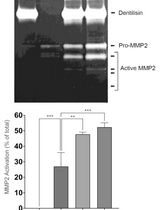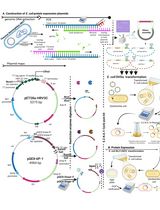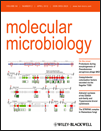- Submit a Protocol
- Receive Our Alerts
- Log in
- /
- Sign up
- My Bio Page
- Edit My Profile
- Change Password
- Log Out
- EN
- EN - English
- CN - 中文
- Protocols
- Articles and Issues
- For Authors
- About
- Become a Reviewer
- EN - English
- CN - 中文
- Home
- Protocols
- Articles and Issues
- For Authors
- About
- Become a Reviewer
Isolation of Inner Membrane Vesicles from Escherichia coli by Using an Affinity Tag
Published: Vol 2, Iss 20, Oct 20, 2012 DOI: 10.21769/BioProtoc.273 Views: 11563

Protocol Collections
Comprehensive collections of detailed, peer-reviewed protocols focusing on specific topics
Related protocols

From Llama to Nanobody: A Streamlined Workflow for the Generation of Functionalised VHHs
Lauren E.-A. Eyssen [...] Raymond J. Owens
Mar 20, 2024 5526 Views

Purification of Native Dentilisin Complex from Treponema denticola by Preparative Continuous Polyacrylamide Gel Electrophoresis and Functional Analysis by Gelatin Zymography
Pachiyappan Kamarajan [...] Yvonne L. Kapila
Apr 5, 2024 1615 Views

Thermus thermophilus CRISPR Cas6 Heterologous Expression and Purification
Junwei Wei [...] Yingjun Li
Jul 20, 2025 1675 Views
Abstract
This protocol was developed in a project aimed to identify the inner membrane proteins localizing to cell poles in Escherichia coli (E. coli). By using a known polar protein Tar as a tag, we isolated pole-derived inner membrane vesicles by affinity capture. The specificity of the polar vesicle isolation was confirmed by mass spectrometry that identified more than one hundred proteins, most of which are known inner membrane proteins, including other known polar proteins. This protocol, or if adapted properly by choosing other affinity targets, is well suited to isolate other membrane domains of interest for identification of proteins or lipid composition.
Materials and Reagents
- Isopropyl β-D-1-thiogalactopyranoside (IPTG)
- Medium copy plasmid pLP8 for recombinant protein expression (Plac lacIq KanR, Li and Young, 2012)
- Bacto Tryptone (BD Biosciences, catalog number: 211705 )
- Halt protease inhibitor (Thermo Fisher Scientific, catalog number: 78425 )
- RNase A (Sigma-Aldrich, catalog number: R5503 )
- DNase I (Thermo Fisher Scientific, catalog number: NC9709009 )
- anti-FLAG M2 affinity gel (Sigma-Aldrich, catalog number: A2220 )
- Poly-Prep chromatography column (Bio-Rad Laboratories, catalog number: 731-1550 )
- Micro BCA protein assay kit (Thermo Fisher Scientific, catalog number: 23235 )
- Triton X-100
- Tween 20
- Tryptone medium
- Phosphate buffered saline (PBS) (see Recipes)
- Phosphate buffered saline with Tween 20 (PBST) (see Recipes)
Equipment
- Centrifuges for 1.5 ml, 10 ml and 100 ml volumes
- High shear fluid processor (Microfluidics, model: LV1 ) or French press
Procedure
- Construct an E. coli strain expressing a tagged recombinant protein. In this experiment, the FLAG-tagged Tar is expressed from an IPTG inducible plasmid.
- Transfer 1 ml overnight E. coli culture to 100 ml 1% Tryptone medium and grow at 30 °C. This is the optimal growth condition for flagellar motility and Tar polar localization. Add 25 μM IPTG after 1 h to induce the target protein tagged with a FLAG epitope (Tar-FLAG). Grow the cells for additional 2-3 h.
- Pellet the cells (6,000 x g for 5 min at room temperature). In this experiment, low temperature affects the normal polar localization of the Tar protein. Use room temperature in the following steps unless otherwise indicated. Resuspend the pellet in 15 ml PBS. Incubate at 30 °C with shaking for 1 h to allow newly synthesized Tar proteins localizing to poles.
- Add 60 μl Halt protease inhibitor. Add 16 μg/ml RNase and 1.3 μg/ml DNase (final concentration). Disrupt the cells with an LV1 high shear fluid processor (Microfluidics) at 20,000 psi (the disruption takes only one sec). Cool the samples immediately on ice.
- Spin (10,000 x g for 5 min at 4 °C) to remove unbroken cells.
- Transfer 10 ml supernatant containing the membrane vesicles to a 15 ml tube. Add 2 ml PBST and mix by inverting the tube several times.
- Add 150 μl anti-FLAG gel beads followed by incubation on ice for 1 h with slow shaking.
- Transfer the mixture to an empty Poly-Prep chromatography column. Snap off the seal at the bottom of the column to allow the liquid to flow.
- Rinse the beads twice with 8 ml cold PBST.
- Cap the bottom of the column. Add 1 ml cold PBST to resuspend the beads. Transfer the mixture to a 1.5 ml tube (this step is important because proteins and vesicles are trapped non-specifically in the bed support layer at the bottom of the column).
- Spin (6,000 x g for 1 min at 4 °C) to pellet the beads. Wash twice with 1 ml cold PBST.
- Resuspend the beads in 85 μl 1% Triton X-100 in PBS and incubated at room temperature for 10 min to solubilize the inner membranes.
- Centrifuge the mixture (6,000 x g for 1 min at room temperature). Transfer the supernatant containing the released proteins to a clean tube for further analysis.
- Wash the pellet with 1 ml 1% Triton X-100 in PBS. Resuspend the pellet in 85 μl 1% SDS in water and incubate at 90 °C for 5 min to elute all other proteins, including the FLAG tagged protein. Centrifuge and collect the supernatant (6,000 x g for 1 min at room temperature).
- Determine protein concentration in the sample using a Micro BCA protein assay kit.
Recipes
- PBS
40 mM sodium phosphate
150 mM sodium chloride (pH 7.4)
- PBST
PBS
0.05% Tween 20
Acknowledgments
Funding for this project was provided by the US Government and managed by the Army Research Office under Award No. W911NF-10-1-0058.
References
- Li, G. and Young, K. D. (2012). Isolation and identification of new inner membrane-associated proteins that localize to cell poles in Escherichia coli. Mol Microbiol 84(2): 276-295.
(This paper was reviewed by Moselio Schaechter in the ASM blog Small Things Considered: Polar Enchantment, May 7, 2012)
Article Information
Copyright
© 2012 The Authors; exclusive licensee Bio-protocol LLC.
How to cite
Li, G. and Young, K. D. (2012). Isolation of Inner Membrane Vesicles from Escherichia coli by Using an Affinity Tag. Bio-protocol 2(20): e273. DOI: 10.21769/BioProtoc.273.
Category
Microbiology > Microbial biochemistry > Protein > Isolation and purification
Microbiology > Microbial cell biology > Organelle isolation
Cell Biology > Organelle isolation > Membrane
Do you have any questions about this protocol?
Post your question to gather feedback from the community. We will also invite the authors of this article to respond.
Tips for asking effective questions
+ Description
Write a detailed description. Include all information that will help others answer your question including experimental processes, conditions, and relevant images.
Share
Bluesky
X
Copy link








